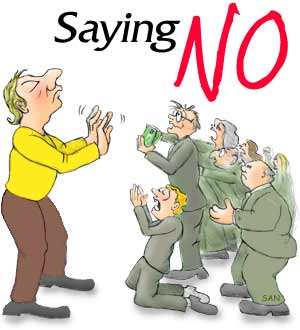
Envision the scenario: You’ve just been asked at the last minute by Chris, the organizer of your local networking group, to replace the scheduled speaker at next month’s meeting. You already have too many commitments on your plate. Imagine your response:
You: “Well, I don’t think I’d have enough time to prepare. I’m awfully sorry. I wish I could help you!.”
Chris: “Your last speech was super’maybe you could just talk some more about that topic? I,d really appreciate it!”
You: “I’m glad you liked it–maybe I could do it”
Chris: “Oh that would be great! Just let me know the title”
How might you feel about doing this speech? You might feel stressed or resentful. You might not be at your best when you do the speech. Other work that you’d really like to be doing might suffer.
Now imagine a different response:
You: “No, I can’t be prepared on such short notice. I know how hard it is to find someone.” Alex speaks on a variety of topics and I think she could fill in for you. I’ll give you her number.”
Chris: “Thanks! That will really help.”
This is a win-win-win: Alex gets an opportunity to speak (her specialty), Chris gets a speaker, and you aren’t saddled with a commitment you don,t want–plus, you,ve probably earned some good will from both Alex and Chris. What a difference!
Whether you are saying no to a collaborator asking you to do something, or saying no to a potential client that you really don’t want to have, the ability to say no gracefully is a key skill when you are in business as a solo entrepreneur. Here are four quick steps to learning this skill:
-
Understand the reasons you say “yes”, even when you don’t really want to. Here are some common reasons; which ones apply to you?
- You want to please people; you don’t want to hurt anyone’s feelings.
- The customer is always right, you can’t say no to the customer!
- It’s not polite to say no; if you say no you feel you are being self-centered.
- You are flattered by the request.
- You feel like you need the business!
- You can’t think of a nice way to say no fast enough.
- You think there might be other unforeseen negative consequencesif you say no.
- Recognize the good things that can come out of saying “no”:
- You have more opportunities to say “yes” to the right customer.
- You have more time to do the things you *want* to do.
- Saying no expresses how you *really* feel. You are taking responsibility for your own feelings and letting others take responsibility for theirs.
- Someone else who really wants this customer’s business, has a chance to get it
- Learn how to say “no” gracefully:
- “No, I can’t do that.” Don’t beat around the bush- put “no” right upfront.
- Use non-verbal cues to underscore the “no”-shake your head; use a firm and direct voice, use eye-contact.
- Add an explanation if you want, but don’t apologize: “I have another commitment.” – even if that commitment is to yourself!
- Be empathetic if the situation calls for it: “I know how hard it is to find a tax-preparer at this time of year.”
- Recommend an alternative if one is available: “Let me refer you to…”
- If you’re not sure, it’s always OK to ask for more timeto think it over!
- Practice your new skill:
- Rehearse ahead of time if you think it will help. Role play with your business coach or a friend or colleague.
- Choose a low-risk situation first. Practice on your significant other, family, friends. Or practice on strangers, if that’s easier for you: the salesclerk who wants to sell you one more thing, the telemarketer calling at dinner.
- Work your way up to friendly clients. They are likely to appreciate the boundaries you are setting!
- When you have the courage to fire that client who hasn’t paid and makes unreasonable demands-you’ll know you’ve mastered saying “NO!” (Hint: refer them to someone else that is a better fit and help manage the transition!)
Saying “no” gives you freedom. It is a way of honoring both yourself and the person you are saying “no” to. Learn to do it well, and you will earn the respect of others–and yourself!

 Russ Lombardo is President of
Russ Lombardo is President of